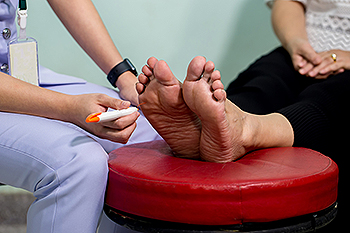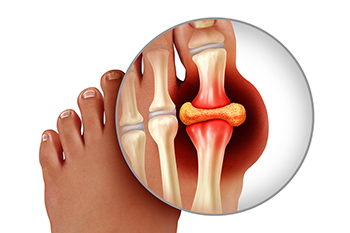Blog
Items filtered by date: April 2022
How Diabetes Can Impact the Feet

When you have diabetes, it is important for you to check your feet each day to make sure you do not have cuts or blisters that are not healing. Since about half of those with diabetes have nerve damage, it can cause one to lose feeling in their feet and they may not be aware there is a problem until it worsens and possibly becomes a more serious issue. It is obvious that the first order of business is managing the diabetes through diet, exercise, and necessary medication, but while this takes place it will be necessary to maintain good foot health practices – washing feet regularly, wearing well-fitting foot coverings, and checking for numbness, tingling, and pain. Those who are older and/or have other physical health problems are said to have a greater risk for complications from diabetic foot problems, such as ulcers or other infections. Since amputation can be the result of untreated foot problems in those with diabetes, it is suggested that regular visits to a podiatrist become part of routine foot health maintenance.
Diabetic foot care is important in preventing foot ailments such as ulcers. If you are suffering from diabetes or have any other concerns about your feet, contact Dr. Dean D. Hinners from Illinois. Our doctor can provide the care you need to keep you pain-free and on your feet.
Diabetic Foot Care
Diabetes affects millions of people every year. The condition can damage blood vessels in many parts of the body, especially the feet. Because of this, taking care of your feet is essential if you have diabetes, and having a podiatrist help monitor your foot health is highly recommended.
The Importance of Caring for Your Feet
- Routinely inspect your feet for bruises or sores.
- Wear socks that fit your feet comfortably.
- Wear comfortable shoes that provide adequate support.
Patients with diabetes should have their doctor monitor their blood levels, as blood sugar levels play such a huge role in diabetic care. Monitoring these levels on a regular basis is highly advised.
It is always best to inform your healthcare professional of any concerns you may have regarding your feet, especially for diabetic patients. Early treatment and routine foot examinations are keys to maintaining proper health, especially because severe complications can arise if proper treatment is not applied.
If you have any questions please feel free to contact one of our offices located in Metropolis and Eldorado, IL . We offer the newest diagnostic and treatment technologies for all your foot and ankle needs.
What Are the Risk Factors for Developing Gout

Gout is an arthritic condition that can cause severe pain, redness, heat and swelling in the big toe joint (typically), as well as other joints. This condition is caused by an excessive amount of uric acid in the bloodstream. Uric acid is a byproduct that is produced when the body processes purines, which are chemical compounds found naturally in the body as well as in certain foods. It is believed that consuming large amounts of alcohol, red and organ meat, certain seafood, and high fructose drinks can increase a person’s risk for developing gout. Other risk factors include heredity, being male and/or obese, and having health conditions such as high blood pressure, diabetes, kidney problems, congestive heart failure, and more. Gout flares are sudden onsets of symptoms which can last for days or even weeks, only to disappear for long periods of time as the disease goes into remission for a time. While there is no cure for gout, a podiatrist can help create a treatment and management plan to manage pain and avoid the condition from worsening.
Gout is a foot condition that requires certain treatment and care. If you are seeking treatment, contact Dr. Dean D. Hinners from Illinois. Our doctor will treat your foot and ankle needs.
What Is Gout?
Gout is a type of arthritis caused by a buildup of uric acid in the bloodstream. It often develops in the foot, especially the big toe area, although it can manifest in other parts of the body as well. Gout can make walking and standing very painful and is especially common in diabetics and the obese.
People typically get gout because of a poor diet. Genetic predisposition is also a factor. The children of parents who have had gout frequently have a chance of developing it themselves.
Gout can easily be identified by redness and inflammation of the big toe and the surrounding areas of the foot. Other symptoms include extreme fatigue, joint pain, and running high fevers. Sometimes corticosteroid drugs can be prescribed to treat gout, but the best way to combat this disease is to get more exercise and eat a better diet.
If you have any questions please feel free to contact one of our offices located in Metropolis and Eldorado, IL . We offer the newest diagnostic and treatment technologies for all your foot and ankle needs.
It's Time for Beautiful Feet
Excessively Sweaty, Smelly Feet
Not all sweaty feet are odorous. Sweaty feet become smelly when bacteria break down sweat that is unable to evaporate by wearing shoes that are too tight or unbreathable, practicing poor hygiene, or wearing socks that do not draw sweat away from skin. It is normal for feet to be sweaty occasionally due to heat, strenuous exercise, and the type of shoes we wear, among other things. Sweat is usually the body’s way of regulating its temperature. However, when sweating is not caused by these common factors and is excessive or persistent, hyperhidrosis (excessive sweating) may be the culprit. Hyperhidrosis is either generalized (affects the whole body) or focal and it typically affects the hands, armpits, groin, or—in the case of palmoplantar hyperhidrosis—the feet. You may have palmoplantar hyperhidrosis if you sweat through your socks frequently, slip around in your shoes, or if your feet look wet, or white. Consult with a podiatrist if you believe your feet sweat excessively. They may treat your hyperhidrosis with prescription topical medications and antiperspirants, Botox injections, or by disabling the sweat glands in your feet temporarily using a gentle electrical current through water.
If you are suffering from hyperhidrosis contact Dr. Dean D. Hinners of Illinois. Our doctor can provide the care you need to attend to all of your foot and ankle needs.
Hyperhidrosis of the Feet
Hyperhidrosis is a rare disorder that can cause people to have excessive sweating of their feet. This can usually occur all on its own without rigorous activity involved. People who suffer from hyperhidrosis may also experience sweaty palms.
Although it is said that sweating is a healthy process meant to cool down the body temperature and to maintain a proper internal temperature, hyperhidrosis may prove to be a huge hindrance on a person’s everyday life.
Plantar hyperhidrosis is considered to be the main form of hyperhidrosis. Secondary hyperhidrosis can refer to sweating that occurs in areas other than the feet or hands and armpits. Often this may be a sign of it being related to another medical condition such as menopause, hyperthyroidism and even Parkinson’s disease.
In order to alleviate this condition, it is important to see your doctor so that they may prescribe the necessary medications so that you can begin to live a normal life again. If this is left untreated, it is said that it will persist throughout an individual’s life.
A last resort approach would be surgery, but it is best to speak with your doctor to find out what may be the best treatment for you.
If you have any questions please feel free to contact one of our offices located in Metropolis and Eldorado, IL . We offer the newest diagnostic and treatment technologies for all your foot and ankle needs.
Where Is the Cuboid Bone Located?
 The cuboid bone is one of seven tarsal bones that are located in the foot. This particular bone is found on the outside of the foot, near the front of the ankle, and this is where pain is felt when the cuboid bone becomes dislocated. It can happen as a result of enduring a break or sprain, and it often causes pain and discomfort. Relief may be found when the affected area is massaged, and a podiatrist may manipulate the cuboid bone back into its normal position. Some patients find it beneficial to wear specific shoes that can help the foot to feel better, in addition to taping the foot for stability. If you have pain in this part of your foot, it is strongly suggested that you speak with a podiatrist as quickly as possible who can offer you correct treatment solutions for cuboid syndrome.
The cuboid bone is one of seven tarsal bones that are located in the foot. This particular bone is found on the outside of the foot, near the front of the ankle, and this is where pain is felt when the cuboid bone becomes dislocated. It can happen as a result of enduring a break or sprain, and it often causes pain and discomfort. Relief may be found when the affected area is massaged, and a podiatrist may manipulate the cuboid bone back into its normal position. Some patients find it beneficial to wear specific shoes that can help the foot to feel better, in addition to taping the foot for stability. If you have pain in this part of your foot, it is strongly suggested that you speak with a podiatrist as quickly as possible who can offer you correct treatment solutions for cuboid syndrome.
Cuboid syndrome, also known as cuboid subluxation, occurs when the joints and ligaments near the cuboid bone in the foot become torn. If you have cuboid syndrome, consult with Dr. Dean D. Hinners from Illinois. Our doctor will assess your condition and provide you with quality foot and ankle treatment.
Cuboid syndrome is a common cause of lateral foot pain, which is pain on the outside of the foot. The condition may happen suddenly due to an ankle sprain, or it may develop slowly overtime from repetitive tension through the bone and surrounding structures.
Causes
The most common causes of cuboid syndrome include:
- Injury – The most common cause of this ailment is an ankle sprain.
- Repetitive Strain – Tension placed through the peroneus longus muscle from repetitive activities such as jumping and running may cause excessive traction on the bone causing it to sublux.
- Altered Foot Biomechanics – Most people suffering from cuboid subluxation have flat feet.
Symptoms
A common symptom of cuboid syndrome is pain along the outside of the foot which can be felt in the ankle and toes. This pain may create walking difficulties and may cause those with the condition to walk with a limp.
Diagnosis
Diagnosis of cuboid syndrome is often difficult, and it is often misdiagnosed. X-rays, MRIs and CT scans often fail to properly show the cuboid subluxation. Although there isn’t a specific test used to diagnose cuboid syndrome, your podiatrist will usually check if pain is felt while pressing firmly on the cuboid bone of your foot.
Treatment
Just as the range of causes varies widely, so do treatments. Some more common treatments are ice therapy, rest, exercise, taping, and orthotics.
If you have any questions, please feel free to contact one of our offices located in Metropolis and Eldorado, IL . We offer the newest diagnostic and treatment technologies for all your foot care needs.


